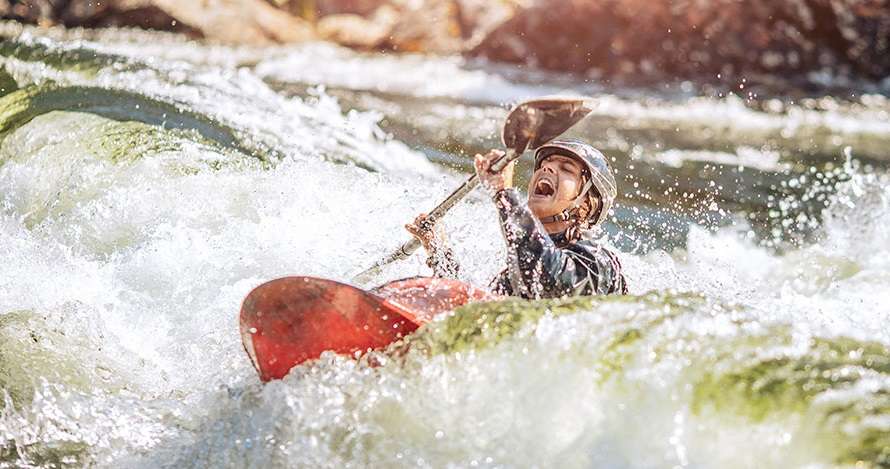Today’s fishing kayaks are stable, capable craft worthy of trust. Even so, we kayak anglers know the sea is full of surprises—and I’m not just talking about hyper-aggressive yellowtail. Follow these simple tips to ensure your kayak-fishing surprises are happy ones.
Wear your PFD
Trouble strikes when we least expect it. Your PFD won’t do any good in the tankwell. And forget about putting on your life vest when you’re on—or worse, in—the water. It’s requires a contortionist’s flexibility even on flatwater, let alone in a building gale. Complaints that PFDs are too uncomfortable to wear may be true of that orange monstrosity from summer camp, but today’s are designed specifically for kayaking. Some even have mesh paneling for ventilation. Another option is a low-profile inflatable PFD such as one produced by SOSpenders. A PFD is also a great place to store safety essentials. A PFD sheath is an ideal spot for the knife you may need to cut yourself free of entangling lines. For signaling, carry a whistle, mirror, submersible marine VHF radio and maybe a flare or two. A compass will help you find your way home through fog.
Save Yourself
Self-rescue is a fancy term for climbing back onto the kayak if you fall off or capsize. It is a simple but essential skill for sit-on-top fishermen, particularly those who venture out solo. Jim Sammons of La Jolla Kayak Fishing teaches surf and safety skills to kayak anglers. He says the easiest self-rescue technique for sit on top kayakers is BBF—shorthand for belly, butt, feet.
First, flip your kayak right side up if necessary. Position yourself on the upwind side of the kayak towards the front of the cockpit. Take your time and perform each step-in sequence: Belly: Place one hand on each side of the cockpit, taking care to elevate your elbows. Now kick vigorously while pressing your upper body out of the water and pulling the kayak under your torso. Continue to kick until you are lying across the kayak on your belly. Butt: Next, roll your hips into the seat, keeping your head low and toward the center of the boat for balance. When you complete this move, you will be sitting sidesaddle in the cockpit. Feet: Now swing your feet into the kayak one at a time, pick up your paddle and get back to chasing fish.
Practice this sequence a few times in calm shallow water. When you’ve got it wired, consider practicing in tougher conditions. If you capsize at sea, chances are the swell will be up and the wind howling. When your friends are around you usually can count on an assisted rescue. After mastering the self rescue, climbing onto a kayak while a helpful hand holds it steady should come easily.
Get Your Drain On
A flooded hull is bad news. It means water is displacing the air that keeps your sit-on-top afloat. That water needs to go, right away. Kayak anglers have sometimes resorted to bailing with a tackle box or bottle. A hand pump is a better choice. Sometimes called kayak pumps, these efficient devices are available at most paddle shops.
Sometimes it’s faster to empty a flooded boat with a friend’s help. Slide the water-filled kayak onto the front of the cockpit of the second kayak, with the hatch of the waterlogged compartment open. Keep pushing the flooded kayak onto the bow of the boat until it nears its balance point, then lift the stern of the flooded boat. Most of the water should drain. Flip the kayak right side up, close the hatch, and get back in the cockpit via an assisted rescue.
Make Peace with the Surf
When you become comfortable paddling in the surf zone you’ll dramatically expand your fishing horizons. The best launch sites are protected from the prevailing swell inside a bay or behind a point. Look for beaches with crumbling surf. Avoid dangerous shore breaks. Watch the surf for several minutes before you launch. Big waves come in sets separated by periods of relative calm.
Wait for one of these lulls, and then go for it aggressively. Don’t slow if an approaching swell looms up. Usually you can power right through. Make sure you hit the wave straight on; if you approach at an angle it’s more likely to turn you sideways and surf you back to the beach. Landing is more difficult. If possible, avoid the risks of surfing to spare your gear. Sneak up on the impact zone, the spot on the beach where most waves break. Wait for the biggest wave of the set to pass, then paddle in hard on its back. Soon the following wave will catch you. Lean back to keep the nose of the kayak from burying itself in the wave. Try to remain straight.
If the wave turns your kayak broadside, lean into the foam pile using your paddle for support, keeping your elbows low and close to your body. At the same time, use your legs to keep the edge of your kayak closest to the beach from catching the wave. Leaning into the pile may run counter to your instinct, but in the surf zone that roaring pile is your best friend. Leave the expensive fishing gear at home and try a surf session once in a while to develop and hone your surf skills. You won’t regret it, but the fish surely will.

